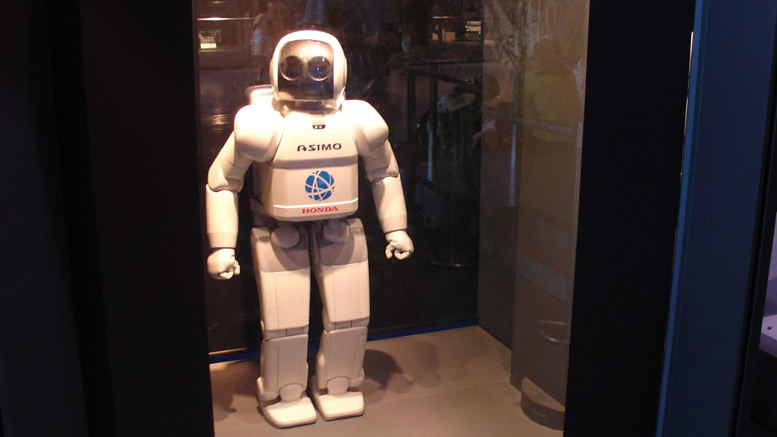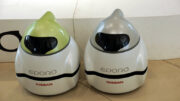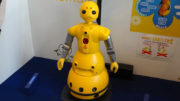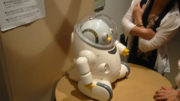
ASIMO (Advanced Step in Innovative MObility) is the result of years of constant research and development Honda to create a huminoid robot.
Honda engineers set out to create an advanced humanoid robot able to function in real-world environments. The first robots Honda began to develop were little more than a pair of legs tethered to a computer but today, after more than 18 years of research and development, ASIMO exhibits an almost real personality and can recognize up to 10 different pre-registered people. He can then greet them by name and communicating messages to them. ASIMO can also recognize postures and gestures like recognize an indicated location and move to that location, shake a person’s hand when a handshake is offered and respond to a wave by waving back.
Honda recently announced the development of three new technologies (as well as improvements to his joints for better flexibility) for the next-generation ASIMO humanoid robot, targeting a new level of mobility that will better enable ASIMO to function and interact with people by quickly processing information and acting more nimbly in real-world environments.
1. Posture Control technology:
The combination of newly developed high-response hardware and the new Posture Control technology enables ASIMO to proactively bend or twist its torso to maintain its balance and prevent the problems of foot slippage and spinning in the air, which accompany movement at higher speeds. ASIMO is now capable of running at a speed of 3km/hour. In addition, walking speed has been increased from the previous 1.6 km/hour to 2.5 km/hour.
2. Autonomous Continuous Movement technology:
The next-generation ASIMO can maneuver toward its destination without stopping by comparing any deviation between the input map information and the information obtained about the surrounding area from its floor surface sensor. Moreover, ASIMO can now autonomously change its path when its floor surface sensor and visual sensors located in its head detect obstacles.
3. Enhanced visual sensor and force sensor technologies allow for smoother interaction with people:
By detecting people’s movements through visual sensors in its head and force (kinesthetic) sensors which have been newly added to its wrists, ASIMO can now move in sync with people allowing it to give or receive an object, shake hands in concert with a person’s movement and step forward or backward in response to the direction its hand is pulled or pushed.
By continuing to advance these new technologies, Honda will pursue development of an ASIMO that will be useful to people.
• Hip rotational joint: Increased walking speed was achieved by the proactive rotation of the hips in addition to swinging of the arms, which cancel the reaction force generated when the legs swing forward during running or walking.
• Wrist bending joint: Due to two additional axes in each wrist, the movement of the wrist area is more flexible.
• Thumb joint: Previously, one motor operated all five fingers. With addition of a motor that operates the thumb independently, ASIMO can now hold objects of various shapes.
• Neck joint: With an additional axis added to its neck joint, ASIMO’s expressiveness has been enhanced.
*More about the new Posture Control technology:
In order to realize “running”, two major obstacles had to be overcome. One was an accurate leap and the absorption of the landing impact, and the second was prevention of the slipping and spinning that accompany movement at higher speeds.
1. Accurate leap and absorption of landing impact:
In order to run, a robot has to be able to repeat the movements of pushing off the ground, swinging its legs forward, landing within a very short time cycle and without any delay, absorbing the instantaneous impact shock of landing. With a newly developed high-speed processing circuit, highly-responsive and high-power motor drive unit, in addition to light-weight and highly rigid leg structure, Honda realized highly accurate and responsive hardware with performance levels more than four times faster compared to that of the previous model.
2. Prevention of spinning and slipping:
Due to reduced pressure between the bottom of the feet and floor, spinning and slipping are more likely to happen right before the foot leaves the floor and right after the foot lands on the floor.
Overcoming the problem of spinning and slipping was the biggest control element challenge related to increasing running speed. Combining Honda’s independently developed theory of bipedal walking control with proactive bending and twisting of the torso, Honda developed a new control theory which enables stable running, while preventing slipping.
Through these technologies, ASIMO is now capable of smooth human-like running at a speed of 3km/hour. Moreover, walking speed was increased from the previous 1.6 km/hour to 2.5 km/hour.
When a human runs, the step cycle is 0.2 to 0.4 seconds depending on one’s speed, and the airborne time, when both feet are off the ground, varies between 0.05 to 0.1 seconds. The step cycle of ASIMO is 0.36 seconds with an airborne time of 0.05 seconds, which are equivalent to that of a person jogging.




